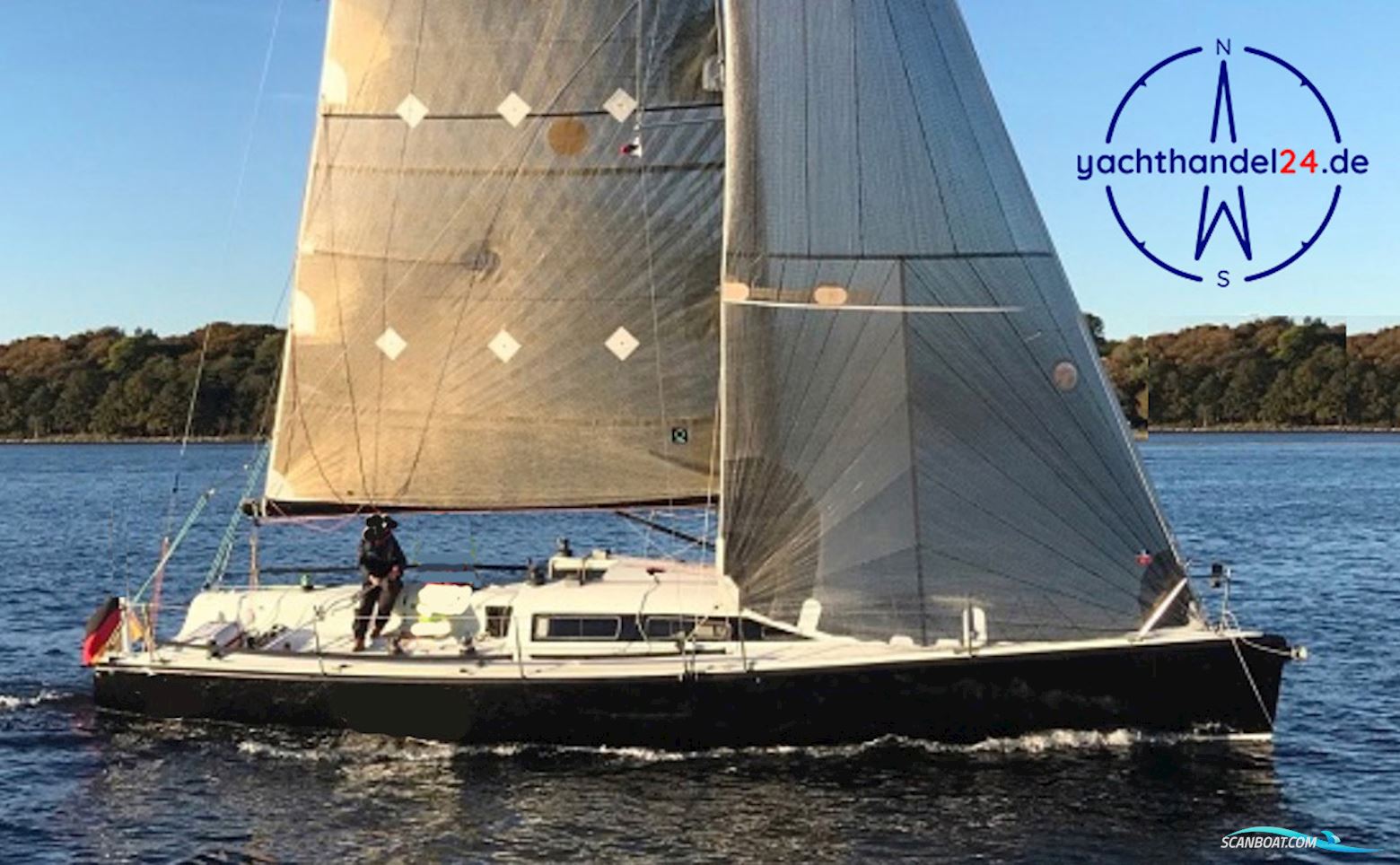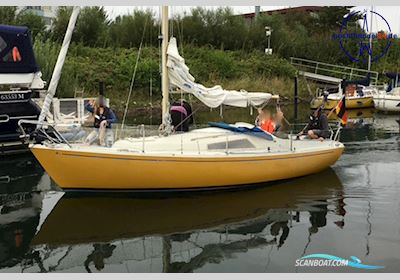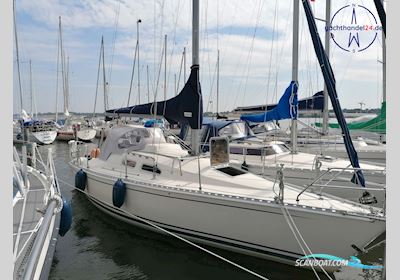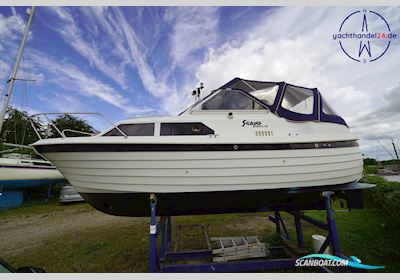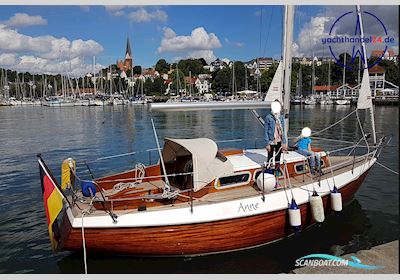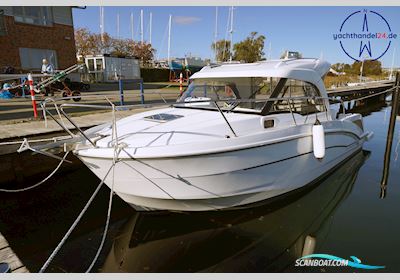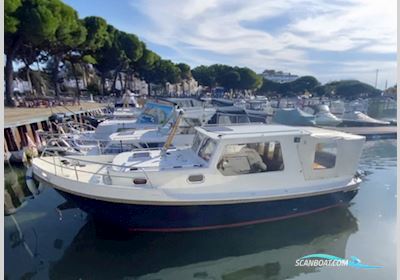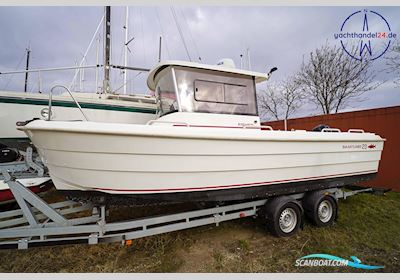We have attached the test report in the appendix, which describes the boat perfectly:
Schock 40, Test Report by Peter Danjou, 29.10.2001
One of the best things about testing new boats is being able to closely examine the innovations that drive the design of racing boats forward.
But rarely can we report on radical concepts that work so well that we want to shout their benefits from the rooftops.
Well, put in your earplugs, because the Schock 40 is here.
It has been 12 years since Tom Blackaller built a 12-meter yacht with fore and aft foils. The Twin-Foil technology used in 1987 was an idea by Charles Robinson, the president of DynaYachts.
It was further developed by the Dyna-Yachts design team led by Matt Brown and Bill Burns on the prototype Red Hornet. The patented Canting Ballast-Twin-Foil system is now integrated into the 40-foot production sportboat.
The arrangement of the two foils is the only innovation.
A swing ballast system reduces the ballast requirement by 60 percent, and the boat's displacement is only 7,000 pounds.
The ballast bulb can be tilted 55 degrees to both sides, and with a push of a button, you can fully reverse the system in nine seconds.
To avoid misunderstandings: this is not a swing keel, but a swing ballast bulb.
The stainless steel fin supports the ball that provides the righting moment.
The twin rudders provide lift and prevent leeway.
When sailing downwind during a race, I was somewhat surprised by how the boat responded. The two rudders are interconnected and work around the boat's pivot point in opposite directions.
I had expected that this would make the boat turn faster, but it steered positively and responsively without being overly sensitive.
The rudders are mounted on stainless steel posts, covered with a composite casing, and supported by Harken rudder bearings. The tiller and rudders are connected through an Edson steering system.
The key is that unlike Blackaller's system, which had two independent steering systems, the rudders work synchronously.
The high-profile foils were wind tunnel tested and feature a unique adjustment called the "Collective," which can change the angle of attack of the foils by up to seven degrees without moving the tiller.
For those concerned about sailing with an exposed forward rudder, Dyna Yacht explains that the rudders are constructed to ABS standards with false tips (on the lower 20 percent) and housed in a crash box.
The hull itself has been reinforced in this area by 30 percent.
According to Co-Designer Brown, the technological advantage of the twin foils goes beyond advanced control and preventing side slip.
Looking at the resistance models of a typical sailboat, you can see a high-pressure area ahead of the keel.
The front foil element dampens this bow wave effect.
The swing ballast system uses a hydraulic cylinder driven by an electric motor to position the ballast.
Through cockpit buttons, the helmsman can adjust the ballast to balance the boat, and a display mounted in the cabin shows the exact angle of the ballast.
The electric motor and servo mechanism are powered by a series of 6-volt batteries separated from the 12-volt onboard system, providing power for 48 hours without the need for recharging.
If needed, the shaft can be manually pumped into the correct position.
The hydraulic unit is hidden behind the navigation station, which can be swung out for easy access, and the battery bank is located on the opposite side to keep the boat balanced.
Two large transverse frames extend to the deck height and support the ballast mechanism between them.
According to Schock, the composite hull construction was made to ABS standards using vinylester resin and woven E-glass fibers over a 1-inch thick PVC foam core, with balsa wood reinforcing high-stress areas.
The chain plates are constructed in a monocoque design and bonded to the hull/deck flange.
The toe rail is only cast into the deck forward of the mast; the entire deck is bonded to the hull flange.
The Schock 40 features a beautiful but spartan interior, including a fully enclosed head. A wide, stainless steel two-step companionway provides easy access to the cabin.
The midship benches double as berths with storage underneath. The cabin is spacious, offering standing headroom, and the six smoke-colored side windows provide ample light.
A hanging locker and storage compartments offer plenty of space for the crew's gear.
Stainless steel tubes serving as conduits for the internal mainsheet system also act as handrails.
The large cockpit was developed with the involvement of America's Cup veteran Peter Isler (and also as an editor at Sailing World for completeness). Isler says, "I tested the prototype, the Red Hornet, for two years. The Schock 40 is incredibly fast, easy to sail, and fun. You feel like David fighting Goliath - that's how fast the boat is."
In addition to Isler's contribution to the layout, his Red Hornet campaign (see Speed by Design, Dec. 97/Jan. 98) established the PHRF rating basis for boats nationwide. With the sixth production hull, a one-design class could develop.
So far, buoy racing with boats with canting ballast has not been very realistic, as moving the ballast during e
Vi har vedlagt testrapporten i vedhæftningen, bedre kan båden ikke beskrives:
Schock 40, testrapport af Peter Danjou, 29.10.2001
En af de bedste ting ved at teste nye både er, at man kan se innovationerne, der driver designet af racerbåde, på nært hold.
Men sjældent kan vi rapportere om radikale koncepter, der fungerer så godt, at vi har lyst til at råbe deres fordele højt fra tagene.
Så tag ørepropperne i, for Schock 40 er her.
Det er 12 år siden, Tom Blackaller byggede en 12-meter yacht med for- og agterror. Twin-Foil-teknologien, der blev brugt i 1987, var en idé fra Charles Robinson, præsident for DynaYachts.
Den blev videreudviklet af Dyna-Yachts designerteam omkring Matt Brown og Bill Burns på prototypen Red Hornet. Det patenterede Canting Ballast-Twin-Foil-system er nu indbygget i den 40-fods serie sportsbåd.
Den eneste nyhed er arrangementet af de to foil. Et svingende ballastsystem reducerer ballastbehovet med 60 procent, og bådens forskydning er kun 7.000 pund.
Ballastbolden kan vippe 55 grader til begge sider, og med et tryk på en knap kan du vende systemet fuldstændigt på ni sekunder.
For at undgå misforståelser: Dette er ikke en svingbar køl, men en svingbar ballastbold.
Den rustfri stålfinne understøtter bolden, der sørger for opretningsmomentet.
De dobbelte ror giver opdrift og forhindrer drivning.
Da jeg sejlede for vinden under et løb, blev jeg lidt overrasket over, hvordan båden reagerede. De to roret er forbundet og arbejder omkring bådens drejningspunkt i modsatte retninger. Jeg havde forventet, at båden dermed ville dreje hurtigere, men den var let og reagerede positivt, uden at være for følsom.
Rorene er monteret på rustfri stolper, beklædt med en kompositdækning og understøttet af Harken-rorlejer. Pinden og rorerne er forbundet med et Edson-styresystem.
Nøglen ligger i, at rorerne i modsætning til Blackallers system, der havde to uafhængige styresystemer, arbejder synkront.
De højprofilerede foil blev testet i vindtunnel og har en unik justeringsmulighed kaldet "Collective", der kan ændre foilernes angrebsvinkel med op til syv grader uden at flytte pinden.
For dem, der har bekymringer ved at sejle med et fritliggende forror, forklarer Dyna Yacht, at rorerne er konstrueret efter ABS-standarder med falske spidser (på de nederste 20 procent) og rorerne er placeret i en crashbox.
Skroget selv er forstærket med 30 procent i dette område.
Ifølge meddesigner Brown går den teknologiske fordel ved de dobbelte foils ud over avanceret styring og forhindring af sideskred.
Når man ser på modellerne af typiske sejlbåde, kan man se et højt trykområde foran kølen.
Det forreste foil-element dæmper denne bovbølgeeffekt.
Svingballastsystemet bruger en hydraulisk cylinder, der drives af en elmotor, til at positionere ballasten.
Styrmanden kan justere ballasten via cockpitknapper for at balancere båden, og en skærm i kahytten viser den præcise vinkel på ballasten. Elmotoren og servomekanismen drives af en række 6-volts batterier, der er adskilt fra 12-volts bordsystemet og leverer strøm i 48 timer uden behov for opladning.
Hvis nødvendigt kan akslen pumpes manuelt til den rigtige position.
Hydraulikenheden er skjult bag navigationsstationen, som kan svinges ud for nem adgang, og batteribanken er placeret på den modsatte side for at holde båden i balance.
To store tværgående rammer strækker sig op til dækshøjde og understøtter ballastmekanismen imellem sig. Ifølge Schock blev skrofkonstruktionen i komposit efter ABS-standarder fremstillet ved brug af vinylesterharpiks og strikkede E-glasfibre over en 1 tomme tyk PVC-skumkerne, hvor balsatræ forstærker områder med høj belastning.
Kædepladerne er fremstillet i monocoque-konstruktion og limet til skrog/dækflangen.
Fodrelingen er kun støbt ind i dækket foran masten; hele dækket er limet til skrogflangen.
Schock 40 har en smuk, men spartansk indretning, herunder et fuldt lukket toilet. En bred, rustfri stige med to trin giver nem adgang til kahytten. Sæderne midtskibs fungerer samtidig som køjer med opbevaringsplads derunder. Kahytten er rummelig, har ståhøjde, og de seks røgfarvede sideruder giver masser af lys. Et hængeskab og opbevaringsrum giver rigelig plads til besætningens udstyr.
Rustfri rør, der fungerer som ledninger til det interne storskotsystem, fungerer samtidig som håndtag.
Det store cockpit blev udviklet med deltagelse af America's Cup-veteranen Peter Isler (og for god ordens skyld også som redaktør hos Sailing World). Isler siger: "Jeg har testet prototypen, Red Hornet, i to år. Schock 40 er utrolig hurtig, let at sejle og sjov. Man føler sig som David, der kæmper mod Goliat - så hurtig er båden."
Ud over Islers bidrag til layoutet har hans Red Hornet-kampagne (se Speed by Design, dec. 97/jan. 98) etableret PHRF-vurderingsgrundlaget for både i hele landet. Med den sjette serie skrog kunne der udvikles en enhedsklasse. Indtil videre har kapsejladser om bojer med både med svingbar ballast ikke været særlig realistiske, da flytning af ballast under sejladsen var en udfordring.
Vi har bifogat testrapporten i bilagan, båten kan inte beskrivas bättre än så här:
Schock 40, Testrapport av Peter Danjou, 29.10.2001
En av de bästa sakerna med att testa nya båtar är att man kan studera innovationerna som driver designen av racerbåtar framåt på nära håll.
Men sällan kan vi rapportera om radikala koncept som fungerar så bra att vi vill skrika om deras fördelar från hustaken.
Så sätt i öronpropparna, för här kommer Schock 40.
Det har gått 12 år sedan Tom Blackaller byggde en 12-meters yacht med för- och akterrorkar. Twin-Foil-teknologin som användes 1987 var en idé av Charles Robinson, president för DynaYachts.
Den utvecklades vidare av Dyna-Yachts designteam runt Matt Brown och Bill Burns på prototypen Red Hornet. Det patenterade Canting Ballast-Twin-Foil-systemet är nu installerat i den 40-fots serie sportbåten.
Den enda nyheten är placeringen av de två foils.
Ett svängbart ballastsystem minskar ballastbehovet med 60 procent, och båtens förskjutning är endast 7 000 pund.
Ballastbollen kan lutas 55 grader åt båda hållen, och med en knapptryckning kan du vända systemet helt på nio sekunder.
För att undvika missförstånd: Detta är inte en svängbar köl, utan en svängbar ballastboll.
Rostfri fenan stöder bollen som ger upprättningsmoment.
De dubbla rodren ger lyft och förhindrar avdrift.
När jag seglade för vinden under en tävling blev jag lite överraskad över hur båten reagerade. De två rodren är sammanlänkade och arbetar runt båtens vridpunkt i motsatta riktningar. Jag hade förväntat mig att båten skulle svänga snabbare på grund av det, men den var lätt att styra, responsiv och inte överkänslig.
Rodren är monterade på rostfria stolpar, klädda med en kompositbeläggning och stöds av Harken-rodurlager. Rorkulten och rodren är anslutna med ett Edson-styrningssystem.
Nyckeln ligger i att rodren, till skillnad från Blackallers system som hade två oberoende styrningssystem, arbetar synkront.
De högprofilerade foils har testats i vindtunnel och har en unik justeringsmöjlighet som kallas "Collective" och kan ändra anfallsvinkeln på foils med upp till sju grader utan att rorkulten rör sig.
För de som är oroade över att segla med ett exponerat främre roder förklarar Dyna Yacht att rodren är konstruerade enligt ABS-standarder med falska spetsar (på de nedre 20 procenten) och att rodren är placerade i en krockbox.
Skrovet har förstärkts med 30 procent i detta område.
.
Enligt meddesignern Brown sträcker sig den teknologiska fördelen med dubbla foils bortom avancerad styrning och sidovindshinder.
När man tittar på motståndsmodellerna för en typisk segelbåt ser man ett högt tryckområde framför kölen.
Det främre foil-elementet dämpar denna bovvågseffekt.
Svängballastsystemet använder en hydraulisk cylinder som drivs av en elmotor för att positionera ballasten.
Styrman kan justera ballasten via knappar i sittbrunnen för att balansera båten, och en display monterad i kabinen visar den exakta vinkeln på ballasten. Elmotorn och servomekanismen drivs av en serie 6-voltsbatterier som är separerade från 12-voltsbordssystemet och ger ström i 48 timmar utan att behöva laddas.
Vid behov kan cylindern manuellt pumpas till rätt position.
Hydraulikenheten är gömd bakom navigationsstationen, som kan svängas ut för enkel åtkomst, och batteribanken är placerad på motsatt sida för att hålla båten i balans.
Två stora tvärbalkar sträcker sig upp till däckshöjden och stöder ballastmekanismen mellan dem.
Enligt Schock har skrovkonstruktionen enligt ABS-standarder utförts med vinylesterhart och stickade E-glasfiber över en 1-tums tjock PVC-skumkärna, med balsaträ som förstärker områden med hög belastning.
Kedjefästena är tillverkade i monocoque-konstruktion och limmade till skrov/däckflänsen.
Foträcket är endast infällt framför masten; hela däcket är limmat till skrovflänsen.
Schock 40 har en vacker men spartansk interiör, inklusive en helt sluten toalett. En bred, rostfri tvåstegs nedgångstrappa ger bekväm tillgång till kabinen. Sittbänkarna mittskepps fungerar samtidigt som kojer med förvaringsutrymme under. Kabinen är rymlig, har ståhöjd och de sex rökfärgade sidorutorna ger mycket ljus. En hängande garderob och förvaringsfack ger gott om plats för besättningens utrustning.
Rostfria rör som fungerar som ledningar för det interna storskotsystemet fungerar samtidigt som handtag.
Den stora sittbrunnen utvecklades med hjälp av America's Cup-veteranen Peter Isler (och för fullständighetens skull även som redaktör på Sailing World). Isler säger: "Jag har testat prototypen, Red Hornet, i två år. Schock 40 är otroligt snabb, lätt att segla och rolig. Man känner sig som David som kämpar mot Goliat - så snabb är båten."
Förutom Islers bidrag till layouten har hans Red Hornet-kampanj (se Speed by Design, dec.
97/jan. 98) etablerat PHRF-bedömningsgrunden för båtar över hela landet. Med den sjätte seriebåten kan en enhetsklass utvecklas. Hittills har regattor runt bojar med båtar med svängbar ballast inte varit särskilt realistiska, eftersom omplaceringen av ballasten under en
In de bijlage hebben we het testrapport toegevoegd, het boot kan niet beter beschreven worden:
Schock 40, Testrapport door Peter Danjou, 29.10.2001
Een van de beste dingen bij het testen van nieuwe boten is dat je de innovaties die het ontwerp van raceboten vooruit helpen, van dichtbij kunt bekijken.
Maar zelden kunnen we rapporteren over radicale concepten die zo goed werken dat we hun voordelen luidkeels van de daken willen schreeuwen.
Dus, doe je oordopjes in, want de Schock 40 is hier.
Het is 12 jaar geleden dat Tom Blackaller een 12-meter jacht met voor- en achterroeren heeft gebouwd. De Twin-Foil-technologie uit 1987 was een idee van Charles Robinson, de president van DynaYachts.
Het gepatenteerde Canting Ballast-Twin-Foil-systeem is nu ingebouwd in de 40-voet serie sportboot.
De opstelling van de twee draagvleugels is de enige innovatie.
Een zwenkballastsysteem vermindert de ballastbehoefte met 60 procent en de waterverplaatsing van de boot is slechts 7.000 pond.
De ballastbal kan 55 graden naar beide zijden kantelen en met een druk op de knop kunt u het systeem in negen seconden volledig omkeren.
Om misverstanden te voorkomen: dit is geen zwenkkiel, maar een zwenkbare ballastbal.
De roestvrijstalen vin ondersteunt de bal die zorgt voor het oprichtmoment.
De dubbele roeren zorgen voor lift en voorkomen afdrijven.
Toen ik tijdens een downwind race zeilde, was ik enigszins verrast door de reactie van de boot. De twee roeren zijn met elkaar verbonden en werken rond het draaipunt van de boot in tegengestelde richtingen. Ik had verwacht dat de boot daardoor sneller zou draaien, maar hij was positief en responsief te besturen, zonder te gevoelig te zijn.
De roeren zijn gemonteerd op roestvrijstalen palen, bekleed met een composietafdekking en ondersteund door Harken roerlagers. De helmstok en de roeren zijn verbonden door een Edson-stuursysteem.
Het sleutelaspect is dat de roeren in tegenstelling tot het systeem van Blackaller, dat over twee onafhankelijke besturingssystemen beschikte, synchroon werken.
De hoogprofiel draagvleugels zijn getest in de windtunnel en hebben een unieke verstelmogelijkheid, genaamd "Collective", die de invalshoek van de draagvleugels tot zeven graden kan veranderen zonder de helmstok te bewegen.
Voor degenen die aarzelen om met een vrijliggend voorroer te zeilen, legt Dyna Yacht uit dat de roeren volgens ABS-normen zijn ontworpen met valse punten (aan de onderste 20 procent) en dat de roeren in een crashbox zijn ondergebracht.
De romp zelf is in dit gebied met 30 procent versterkt.
Volgens mede-ontwerper Brown gaat het technologische voordeel van de dubbele foils verder dan geavanceerde besturing en het voorkomen van zijwind.
Als je kijkt naar de weerstandsmodellen van een typische zeilboot, zie je een hoge druk voor de kiel.
Het voorste draagvleugelelement dempt dit boeggolfeffect.
Het zwenkballastsysteem maakt gebruik van een hydraulische cilinder die wordt aangedreven door een elektrische motor om de ballast te positioneren.
Via cockpitknoppen kan de stuurman de ballast aanpassen om de boot in balans te brengen, en een display in de cabine toont de exacte hoek van de ballast aan. De elektrische motor en de servomechanisme worden aangedreven door een reeks 6-volt batterijen die gescheiden zijn van het 12-volt boordsysteem en 48 uur lang stroom leveren zonder opladen nodig is.
Indien nodig kan de as handmatig in de juiste positie worden gepompt.
De hydraulische unit is verborgen achter het navigatiestation, dat voor gemakkelijke toegang kan worden uitgeklapt, en de batterijbank bevindt zich aan de tegenovergestelde zijde om de boot in balans te houden.
Twee grote dwarsspanten reiken tot aan de dekhoogte en ondersteunen het ballastmechanisme tussen hen in. Volgens Schock is de composietrompconstructie volgens ABS-normen vervaardigd met behulp van vinylesterhars en gebreide E-glasvezels boven een 1 inch dikke PVC-schuimkern, waarbij balsahout de gebieden met hoge belasting versterkt.
De kettingplaten zijn vervaardigd in monocoque constructie en gelijmd aan de romp/dekflens.
De voetrailing is alleen voor de mast in het dek gegoten; het hele dek is gelijmd aan de rompflens.
De Schock 40 heeft een mooie maar sobere interieurinrichting, inclusief een volledig afgesloten toilet. Een brede, roestvrijstalen tweestaps neergangstrap biedt gemakkelijke toegang tot de cabine. De banken in het midden van het schip dienen tegelijkertijd als kooien met opbergruimte eronder. De cabine is ruim, biedt stahoogte en de zes rookkleurige zijruiten zorgen voor veel licht. Een hangkast en opbergvakken bieden voldoende ruimte voor de uitrusting van de bemanning.
Roestvrijstalen buizen die dienen als leidingen voor het interne grootzeilsysteem fungeren tegelijkertijd als handgrepen.
Het grote cockpit is ontworpen met medewerking van America's Cup-veteraan Peter Isler (en ook als redacteur bij Sailing World). Isler zegt: "Ik heb de prototype, de Red Hornet, twee jaar lang getest. De Schock 40 is ongelooflijk snel, gemakkelijk te zeilen en leuk. Je voelt je als David die tegen Goliath vecht - zo snel is de boot."
Naast Islers bijdrage aan het ontwerp heeft zijn Red Hornet-campagne (zie Speed by Design, dec. 97/jan. 98) de PHRF-beoordelingsbasis voor boten in het hele land vastgesteld. Met de zesde serie romp zou een eenheidsklasse kunnen ontstaan. Tot nu toe waren boeiraces met boten met kantelbare ballast niet erg realistisch, omdat het verplaatsen van de ballast tijdens e
wir haben in der Anlage den Testbericht beigefügt, besser kann man das Boot nicht beschreiben:
Schock 40, Testbericht von Peter Danjou, 29.10.2001
Eines der besten Dinge beim Testen neuer Boote ist, dass man die Innovationen, die das Design von Rennbooten vorantreiben, aus nächster Nähe betrachten kann.
Aber nur selten können wir über radikale Konzepte berichten, die so gut funktionieren, dass
wir ihre Vorteile lautstark von den Dächern schreien möchten.
Nun, stecken Sie sich die Ohrstöpsel rein, denn die Schock 40 ist da.
Es ist 12 Jahre her, seit Tom Blackaller eine 12-Meter-Yacht mit Vor- und Achterrudern gebaut hat. Die 1987 verwendete Twin-Foil-Technologie war eine Idee von Charles Robinson, dem Präsidenten von DynaYachts.
Sie wurde vom Dyna-Yachts-Designteam um Matt Brown und Bill Burns am Prototyp Red Hornet weiterentwickelt. Das patentierte Canting Ballast-Twin-Foil-System ist jetzt in dem 40-Fuß-Serien-Sportboot verbaut.
Die Anordnung der beiden Tragflächen ist die einzige Neuerung.
Ein Schwenkballastsystem reduziert den Ballastbedarf um 60 Prozent, und die Verdrängung des Bootes beträgt nur 7.000 Pfund.
Der Ballastball kann um 55 Grad zu beiden Seiten gekippt werden, und mit einem Knopfdruck können Sie das System in neun Sekunden vollständig wenden.
Um Missverständnisse zu vermeiden: Es handelt sich hierbei nicht um einen schwenkbaren Kiel, sondern um einen schwenkbaren Ballastball.
Die Edelstahlflosse stützt den Ball, der für das Aufrichtmoment sorgt.
Die Doppelruder sorgen für Auftrieb und verhindern Abdrift.
Als ich während eines Rennens vor dem Wind segelte, war ich etwas überrascht, wie das Boot reagierte. Die beiden Ruder sind miteinander verbunden und arbeiten um den Drehpunkt des
Bootes herum in entgegengesetzte Richtungen. Ich hatte erwartet, dass, dass das Boot dadurch schneller drehen würde, aber es ließ sich positiv und reaktionsschnell steuern, ohne
überempfindlich zu sein.
Die Ruder sind auf Edelstahlpfosten montiert, mit einer Verbundstoffabdeckung verkleidet und
durch Harken-Ruderlager gestützt. Die Pinne und die Ruder sind durch ein Edson-Steuersystem miteinander verbunden.
Der Schlüssel liegt darin, dass die Ruder im Gegensatz zum Blackallers-System, das über zwei
unabhängige Steuersysteme verfügte, synchron arbeiten.
Die hochprofiligen Tragflächen wurden im Windkanal getestet und verfügen über eine einzigartige
Verstellmöglichkeit, die als „Collective“ bezeichnet wird und den Anstellwinkel der Tragflächen
um bis zu sieben Grad verändern kann, ohne die Pinne zu bewegen.
Für diejenigen, die Bedenken haben, mit einem freiliegenden vorderen Ruder zu segeln, erklärt Dyna Yacht, dass die Ruder nach ABS-Standards mit falschen Spitzen (an den unteren 20 Prozent) konstruiert sind und die Ruder in einer Crashbox untergebracht sind.
Der Rumpf selbst wurde in diesem Bereich um 30 Prozent verstärkt.
.
Laut Co-Designer Brown geht der technologische Vorteil der Doppelfoils über die fortschrittliche
Steuerung und die Verhinderung von Seitenwind hinaus.
Wenn man sich die Widerstandsmodelle eines typischen Segelboots ansieht, erkennt man einen hohen Druckbereich vor dem Kiel.
Das vordere Tragflügelelement dämpft diesen Bugwellen-Effekt.
Das Schwenkballastsystem verwendet einen hydraulischen Zylinder, der von einem Elektromotor angetrieben wird, um den Ballast zu positionieren.
Über Cockpit-Knöpfe kann der Steuermann den Ballast einstellen, um das Boot auszugleichen,
und eine in der Kabine angebrachte Anzeige zeigt den genauen Winkel des Ballasts an. Der Elektromotor und der Servomechanismus werden von einer Reihe von 6-Volt-Batterien ange-trieben, die vom 12-Volt-Bordsystem getrennt sind und 48 Stunden lang Strom liefern, ohne dass eine Aufladung erforderlich ist.
Bei Bedarf kann die Welle manuell in die richtige Position gepumpt werden.
Die Hydraulikeinheit ist hinter der Navigationsstation versteckt, die für einen einfachen Zugang herausgeschwenkt werden kann, und die Batteriebank befindet sich auf der gegenüberliegenden Seite, um das Boot im Gleichgewicht zu halten.
Zwei große Querrahmen reichen bis zur Deckshöhe und stützen den Ballastmechanismus zwischen
sich. Laut Schock wurde die Verbundrumpfkonstruktion nach ABS-Standards unter Verwendung von Vinylesterharz und gestrickten E-Glasfasern über einem 1 Zoll dicken PVC-Schaumkern gefertigt, wobei Balsaholz die Bereiche mit hoher Belastung verstärkt.
Die Kettenplatten sind in Monocoque-Bauweise gefertigt und mit dem Rumpf/Deckflansch verklebt.
Die Fußreling ist nur vor dem Mast in das Deck eingegossen; das gesamte Deck ist mit dem Rumpfflansch verklebt.
Die Schock 40 verfügt über eine schöne, aber spartanische Innenausstattung, einschließlich einer vollständig geschlossenen Toilette. Eine breite, rostfreie zweistufige Niedergangstreppe ermöglicht einen bequemen Zugang zur Kabine. Die Sitzbänke mittschiffs dienen gleichzeitig als Kojen
mit Stauraum darunter. Die Kabine ist geräumig, bietet Stehhöhe und die sechs rauchfarbenen
Seitenscheiben sorgen für viel Licht. Ein Hängeschrank und Staufächer bieten reichlich Platz für die Ausrüstung der Crew.
Edelstahlrohre, die als Leitungen für das interne Großschot-System dienen, fungieren gleichzeitig als Haltegriffe.
Das große Cockpit wurde unter Mitwirkung des America's Cup-Veteranen Peter Isler (und
der Vollständigkeit halber auch als Redakteur bei Sailing World) entwickelt. Isler sagt: „Ich habe den Prototyp, die Red Hornet, zwei Jahre lang getestet. Die Schock 40 ist unglaublich schnell,
leicht zu segeln und macht Spaß. Man fühlt sich David, der gegen Goliath kämpft – so schnell ist das Boot.“
Neben Islers Beitrag zum Layout hat seine Red Hornet-Kampagne (siehe Speed by Design, Dez.
97/Jan. 98) die PHRF-Bewertungsgrundlage für Boote im ganzen Land etabliert. Mit dem sechsten Serienrumpf könnte sich eine Einheitsklasse entwickeln. Bisher waren Regatten um Bojen mit Booten mit kippbarem Ballast nicht sehr realistisch, da das Verlegen des Ballasts während e


